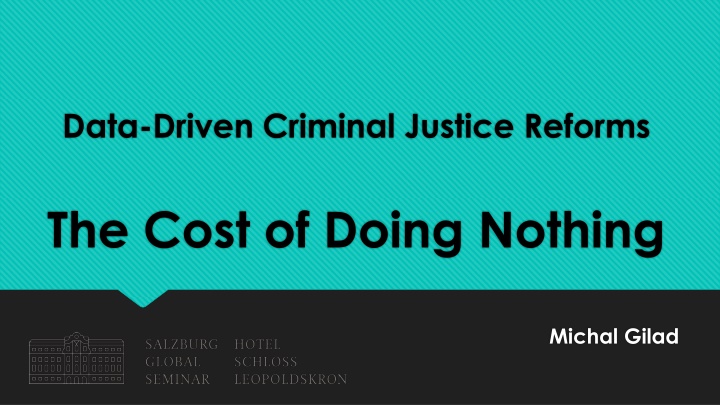
The Cost of Inaction in Criminal Justice Reforms
Explore the profound impacts of inaction in criminal justice reforms, from the unique needs of target populations to the long-term outcomes of policy decisions. Discover how early intervention can mitigate risks and the staggering costs associated with untreated exposure. Gain insights into evidence-based solutions and the potential savings they offer.
Download Presentation

Please find below an Image/Link to download the presentation.
The content on the website is provided AS IS for your information and personal use only. It may not be sold, licensed, or shared on other websites without obtaining consent from the author. If you encounter any issues during the download, it is possible that the publisher has removed the file from their server.
You are allowed to download the files provided on this website for personal or commercial use, subject to the condition that they are used lawfully. All files are the property of their respective owners.
The content on the website is provided AS IS for your information and personal use only. It may not be sold, licensed, or shared on other websites without obtaining consent from the author.
E N D
Presentation Transcript
Data-Driven Criminal Justice Reforms The Cost of Doing Nothing Michal Gilad
The Value of Research to Policy Understanding the unique needs and characteristics of target populations Uncovering the long-term outcomes of policy decisions
What Can We Learn From Science? Children are not miniature adults Children are more vulnerable to the effect of violent crime Violence is a learned behavior The most predictive risk factor for violence is untreated childhood exposure Early intervention alleviates the risk
Prevalence A National Crisis % of Exposure in U.S. Population Under 18 Direct Victimizatio n 52.3 56.1 48.3 Family Violence Community Violence Parental Incarceration Parental Victimization Any 1 Exposure Total 22.9 21.9 24.0 34.9 36.8 32.8 4.8 5.2 4.4 No Data No Data No Data 64.1 66.5 61.6 Male Female The Vast Majority of exposed individuals remain untreated
Outcomes Cancer Delinquency Criminal Behavior Substance Use Disorder Re-victimization COPD Asthma PTSD Heart Attack Depression Skeletal Fractures Anxiety Diabetes Suicide Attempts STDs Poor Educational Outcomes Poor Employment Outcomes
The Cost of Doing Nothing Table 10: Total Cost by Outcome Category Outcome Total Lifetime Cost Average Total Annual Cost Per-person Total Annual Costs for All Affected Adults in the U.S. Per-Person $7,720 (6,159, 9,364) $12,931 (7,529, 18,426) $7,704 (4,628, 10,122) $3,837 (1,541, 7,537) $162,231 $194,413 (182,088, 207,680) $131 (105, 159) $220 (128, 313) $131 (79,172) $65 (26, 128) $2,754 $3,301 (3,091, 3,526) $19,713,327,765 (15,727,339,289, 23,911,075,157) $33,019,906,500 (19,225,162,171, 47,051,877,699) $19,671,359,196 (11,817,177,879, 25,846,233,753) $9,772,156,101 (3,935,294,353, 19,246,115,222) $414,261,170,011 $496,437,919,573 (464,966,143,702, 530,316,471,841) Criminal Justice Substance Use Mental Health Physical Health Productivity Total
Policy Implications Gauging the size of the problem Designing cost effective solutions Maximizing limited resources Incentive for policymakers Potential source for significant savings Evidence-based support for the economic feasibility of early identification, referral and intervention.
Eyes to the Future More nationally representative data Collecting updated post-covid data Assuring that research findings are accessible
For more information or collaboration Michal Gilad: gmichal@pennlaw.upenn.edu
The Cost of the Status Quo How much does it cost us to do nothing? Prevalence how many individuals affected? Outcomes what are the long term consequences of doing nothing Attributable risk specific increase in risk for outcome to occur after controlling for competing causes Cost the monetary cost of each expected outcome
Root Causes Policies not specifically designed for Children Access barriers No identification No effective referral to trauma treatment Over-reliance on parental initiative Poor public information Lack of coordination between stakeholders
Number of State Victim Compensation Claims (2015): State Category VC Claims in 2015 35 Exposure to Family Crime Arizona California Iowa 35 Exposure to Community Crime 21 Exposure to Family Crime 0 Exposure to Family Crime 0 Kentucky Exposure to Community Crime Parental Victimization 0 0 Exposure to Family Crime Maine 15 Exposure to Family Crime Montana 0 Exposure to Community Crime 1 Exposure to Family Crime Nebraska 0 Exposure to Community Crime 0 Exposure to Family Crime Nevada Virginia West Virginia 0 Exposure to Family Crime 0 Exposure to Community Crime
Risk Factors Gender Exposure to violence Victimization At home At school Neighborhood Media Social rejection Impulsive personality traits Substance use Economic disadvantage Delinquent peers Marginalization Low community participation Low parental involvement Poor social and communication skills Mental health Normalization Academic disengagement





















